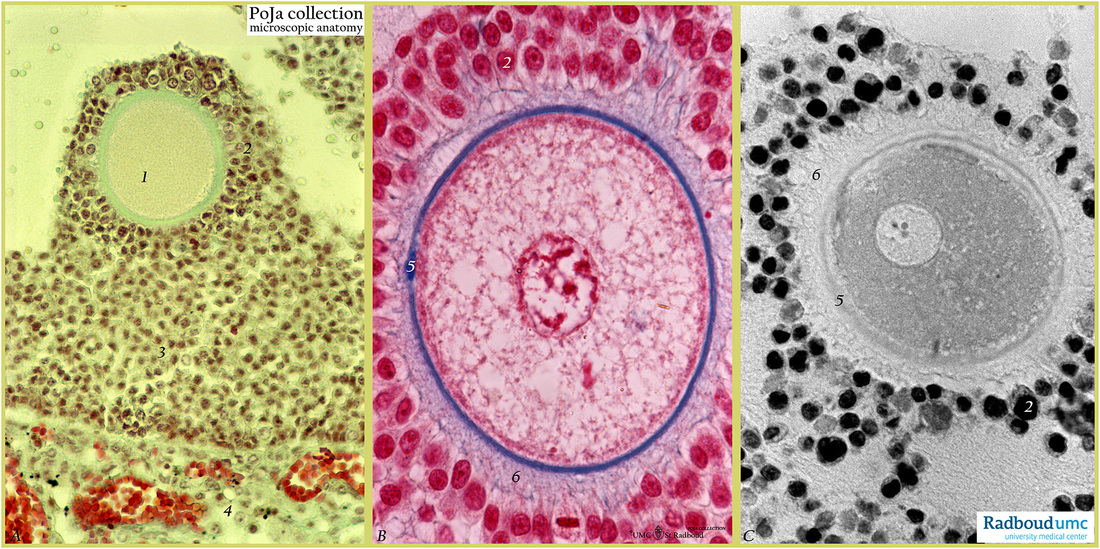7.1 POJA-L1623+1626+1928
Title: Oocyte in mature follicle in ovary (human, rabbit)
Description: Stain: (A) Trichrome (Goldner) (human); (B) Azan (rabbit); (C) Hematoxylin black-white image (human). See also scheme in POJA-L1201+l1231.
(A): Oocyte (nucleus not sectioned) of a tertiary follicle type 5. A thick green zona pellucida marks boundary between oocyte (1) and radially arranged granulosa cells forming the corona radiata (2). The so-called cumulus oophorus (or cumulus ovaricus) (3) is formed by a heap of granulosa cells that “carries” the oocyte and is localized at one pole only in the follicle. Prominent theca interna cells with thin-walled blood vessels (4) lie close to cumulus granulosa cells.
(B): At high magnification: deep blue-stained zona pellucida (5) between oocyte with nucleus and corona radiata cells (2). Note a bluished rim (6) with thin extensions of granulosa cells surrounding and in contact with the zona pellucida.
(C): Hematoxylin-stained mature oocyte (from tertiary follicle type 5+) shows distinct light-reflecting zona pellucida (5). Corona radiata cells (2) are loosely attached with thin extensions (6) leaving antrum space filled with liquid.
Background: The zona pellucida (ZP) has a role in sperm binding including preventing polyspermy, development of the blastocyst and preventing premature implantation. It is a specialized extracellular multilaminar matrix of glycoproteins (Gp’s) surrounding the developing oocyte. ZP glycoproteins (ZPGp’s) are present in both the oocyte and granulosa cells as early as in the primordial follicle stage in human. Secretions from both the oocyte and the granulosa cells form ZP. The ZP contains four Gp’s (ZPGp’s 1 to 4) in human, which are synthesized, secreted and assembled during folliculogenesis. There is a concomitance in the increase of thickness of ZP and diameter of oocyte while ZPGp’s 1 to 4 are synthesized co-coordinately exclusively by growing and full-grown oocytes. The ZP plays an important role in the fertilization process. It is known that capacitation (occurring while sperm reside in the female reproductive tract 1 up to 6 hours) includes the process of loss of spermatozoal glycocalyx as well as vesiculation of the acrosome of spermatozoon. In the binding process of spermatozoa oligosaccharides linked to ZPGp3 interact with sperm receptors. It appears that only acrosome-reacted spermatozoon can interact with ZPGp3.
Keywords/Mesh: female reproductive organs, ovary, ovarian follicle, zona pellucida, granulosa cells, corona radiata, theca interna, female genitalia, histology, POJA collection
Title: Oocyte in mature follicle in ovary (human, rabbit)
Description: Stain: (A) Trichrome (Goldner) (human); (B) Azan (rabbit); (C) Hematoxylin black-white image (human). See also scheme in POJA-L1201+l1231.
(A): Oocyte (nucleus not sectioned) of a tertiary follicle type 5. A thick green zona pellucida marks boundary between oocyte (1) and radially arranged granulosa cells forming the corona radiata (2). The so-called cumulus oophorus (or cumulus ovaricus) (3) is formed by a heap of granulosa cells that “carries” the oocyte and is localized at one pole only in the follicle. Prominent theca interna cells with thin-walled blood vessels (4) lie close to cumulus granulosa cells.
(B): At high magnification: deep blue-stained zona pellucida (5) between oocyte with nucleus and corona radiata cells (2). Note a bluished rim (6) with thin extensions of granulosa cells surrounding and in contact with the zona pellucida.
(C): Hematoxylin-stained mature oocyte (from tertiary follicle type 5+) shows distinct light-reflecting zona pellucida (5). Corona radiata cells (2) are loosely attached with thin extensions (6) leaving antrum space filled with liquid.
Background: The zona pellucida (ZP) has a role in sperm binding including preventing polyspermy, development of the blastocyst and preventing premature implantation. It is a specialized extracellular multilaminar matrix of glycoproteins (Gp’s) surrounding the developing oocyte. ZP glycoproteins (ZPGp’s) are present in both the oocyte and granulosa cells as early as in the primordial follicle stage in human. Secretions from both the oocyte and the granulosa cells form ZP. The ZP contains four Gp’s (ZPGp’s 1 to 4) in human, which are synthesized, secreted and assembled during folliculogenesis. There is a concomitance in the increase of thickness of ZP and diameter of oocyte while ZPGp’s 1 to 4 are synthesized co-coordinately exclusively by growing and full-grown oocytes. The ZP plays an important role in the fertilization process. It is known that capacitation (occurring while sperm reside in the female reproductive tract 1 up to 6 hours) includes the process of loss of spermatozoal glycocalyx as well as vesiculation of the acrosome of spermatozoon. In the binding process of spermatozoa oligosaccharides linked to ZPGp3 interact with sperm receptors. It appears that only acrosome-reacted spermatozoon can interact with ZPGp3.
Keywords/Mesh: female reproductive organs, ovary, ovarian follicle, zona pellucida, granulosa cells, corona radiata, theca interna, female genitalia, histology, POJA collection

